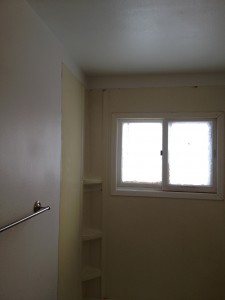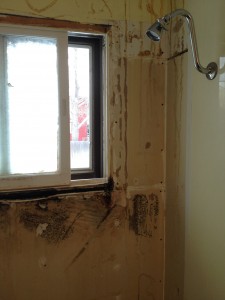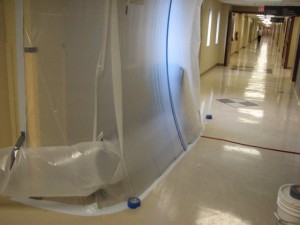When you smell bleach, what’s the first thing you think of?
Normally, the scent of Bleach gives us the assurance that whatever we are cleaning, is indeed getting cleaned and disinfected. It’s a go to cleaner and even given out after disasters by the gallons to home and business owners for the assistance of helping with the cleanup—especially after a major flood.

Take a look at the picture on the left. It shows a little-teensy bit of mold at the top of the shower. It’s almost hard to see. Now you grab the bleach cleaner, spray it on the shower, and wipe it down and you’re done. Great. That mess is taken care of, right?
Truth is, you just helped the mold get ready for a party at your house. Here’s why:
Bleach’s active ingredient is Sodium Hypochlorite and it is highly effective in removing any discoloration. In regards to mold, it may bleach out the discoloration caused by mold growth, but it leaves behind the microflora (the roots of mold) that will start to regrow overtime leaving you with another mold spot. Think of it of having your hair bleached, after it’s been done it looks nice, but in a few months, you’ll have roots that grow out and need to be bleached again.
Another ingredient in Bleach is water. Water is a food source for mold. So, pouring bleach on mold gives it a new look, a new smell, and a big meal that will make it want to come back even more because of your great hospitality. Along with giving it a free meal, pouring liquid on mold can cause sporulation, meaning the mold wants to stay at your house and sends out little seeds to the rest of your house. Have you ever blown the seeds off of a dandelion? Think of mold and liquid the same way—the seeds go everywhere.

Here’s a picture of the same bathroom from above without the shower insert. Mold has spread all behind the shower and into the building material leaving a giant, unhealthy, expensive mess that bleach won’t cleanup.
In order to eliminate the mold and prevent future mold growth, you need to contain and eliminate it completely, rather than just cleaning the surface with Bleach.
This is where it gets technical. Killing mold requires a very specific Biocide Cleaner. On top of that, industry standard recommends physically removing mold contamination. Because everyone reacts differently to mold spores and the gases it gives off differently, ARS takes great care in remediating mold. ARS Mold Technicians build a containment area, they wear protective clothing and respirators, and use special HEPA Vacuums and Air Scrubbers to ensure mold isn’t spread into other areas. 
So, before you grab your bottle of Bleach Cleanup to spray an area affected with mold, consider giving ARS a call to check it out before it takes over the whole house.


